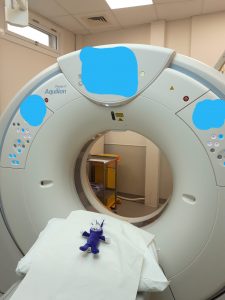Emma’s story: life after diagnosis
“Life may never be the same after the operation, but the key word is LIFE and I am grateful to be here for both myself & for my family and friends. If it’s an altered life going forward, then so be it.”
Emma was diagnosed with a brain tumour at the end of last year, and has been sharing her updates on her blog, detailing how she has approached life after diagnosis.
10.12.19 Plot twist
With every story comes a plot twist, and unfortunately mine comes in the shape of a recent brain tumour diagnosis. 2019 has been a tricky year so far including losing a close family member, so it was a huge shock to receive such news for me and my family. I’ve been a bit quiet on social media of late as have been finding it difficult to focus and concentrate, and this may have been one of the reasons why! But, why let things stop you. I enjoy writing, and even though this isn’t a health blog, it is part of our family life right now so I thought I’d write about what’s been going on (it’s quite cathartic too).

I am very glad that it has been discovered, and therefore won’t be allowed to grow any bigger, but the prospect of brain surgery is very scary. I shall acknowledge the risks and just be brave. Of course the thoughts of losing my eyesight, use of my facial muscles, paralysis and even death have crossed my mind, but it’s only natural to worry. The truth is that we are lucky to have access to excellent healthcare in this country and I read about all the wonderful things they can do now. Apparently I will need some sort of ‘spare part’ inside. Who knows what that’s all about, I look forward to hearing more from the neurosurgeon perhaps later this month or early next.
Little C knows that I have been ill, and that there is ‘a funny bone growing inside my head’ that the doctors might need to take out. She has given me a little purple bunny of hers to keep with me whenever I’ve been in the hospital, so sweet.
Going ahead with surgery?
So the good news is that they’ve found it and that they can operate. They can’t say whether it’s 100% non-malignant until they go in there and take a biopsy. Chances are that it is and it is slow-growing. However, as it is causing issues now, we need to serve the pesky tumour it’s eviction notice! They won’t be able to take it all out, so it may mean future surgeries. Life may never be the same after the operation, but the key word is LIFE and I am grateful to be here for both myself & for my family and friends. If it’s an altered life going forward, then so be it. As Elsa in Frozen 2 sings, it’s definitely a journey ‘into the unknown’. At the moment, I would just like to be out of pain and discomfort as I’ve been quite poorly these last few weeks and popping pills like sweeties!
23.01.20 Things change
At the end of 2019, the ophthalmologist and the neurosurgeon were talking about the complex surgery that I would need to have. However, after further scans and analysis, it looks like I may have been granted a reprieve for a while. It is in a difficult location which means that the risks of surgery far outweigh the benefits right now. They do not know how quick it is growing, as they have nothing to compare it to at the moment. The radiologists plan to scan again in 6 months and go from there.
They will operate as soon as it (1) gets bigger and starts to cause serious issues (e.g. problems with my vision, seizures etc) (2) it compromises my optic nerve or (3) my eye sticks out more. I’ve been fortunate enough to have seen two neurosurgeons on my journey so far, the second of which has offered a greater understanding of the situation in more detail.

Coping with anxiety
As you can appreciate, it is a touch scary to find out you have something growing inside your head that shouldn’t be! The anxiety about how badly something is wrong, and what could go wrong with your health with it being there takes a while to get your head around (if you pardon the pun). Also the thought that I may well need such a serious operation in future is quite daunting.
Being seen on the NHS is fantastic and great, but there is not much practical/emotional support. Sometimes I’m told to go and ‘google’ things, and sometimes I’m told not to. However as a human being, I’m naturally curious to understand everything that is going on, and also what may or may not be ahead.
Support outside the hospital – brainstrust
brainstrust have been absolutely amazing from the word go. First of all, they sent me a ‘Brain Box’ through the post.
The wealth of information contained in the Brain Box was amazing and I am so grateful to have received it. What astounded me as well, was the little extras they’d put in there too. A cup of tea each for me and my fiancée. Some shower gel and lip balm for a little luxury for me. And for Little C some beautiful hand-knitted cuddly toys. She was so pleased to receive the elephant and teddy bears. What a kind thought.

As well as the Brain Box, which to be honest has been a bit like a bible to me, Jodie, the brainstrust support worker for the West Midlands region has been a modern day angel. She has kept in contact with me, answering any questions that I have and even very kindly arranged for me to have a second opinion of my case in London. Just knowing that she is there to answer any questions I have, no matter how big or small is brilliant. She answers questions with the perfect mix of professionalism and empathy and I am lucky to have her!
Looking to the future
2020 is set to be a busy year, so even though this is part of my life now, it doesn’t define it. There are far more interesting things on the horizon. Our little girl starts school this year so we are ramping up for reception! Also the whole year is a blank page ready to fill with lots of happy memory making with my wonderful family and friends. We have got a wedding to plan and I also want to start writing more on my blog so there’s a lot to be getting on with. Fingers crossed the health behaves itself and the rest will follow.
Emma has set up a JustGiving page to fundraise for brainstrust because:
“It’s the least I can do to say a big thank you. brainstrust’s vision is that everyone with a brain tumour should feel less afraid, less alone and more in control. They provide invaluable support to patients and their families and are a definite worthy cause. If you can help, please do so where you can.”
You can visit her page and send a donation here.
If you, or someone you love, has been diagnosed with a brain tumour, give us an email to hello@brainstrust.org.uk









